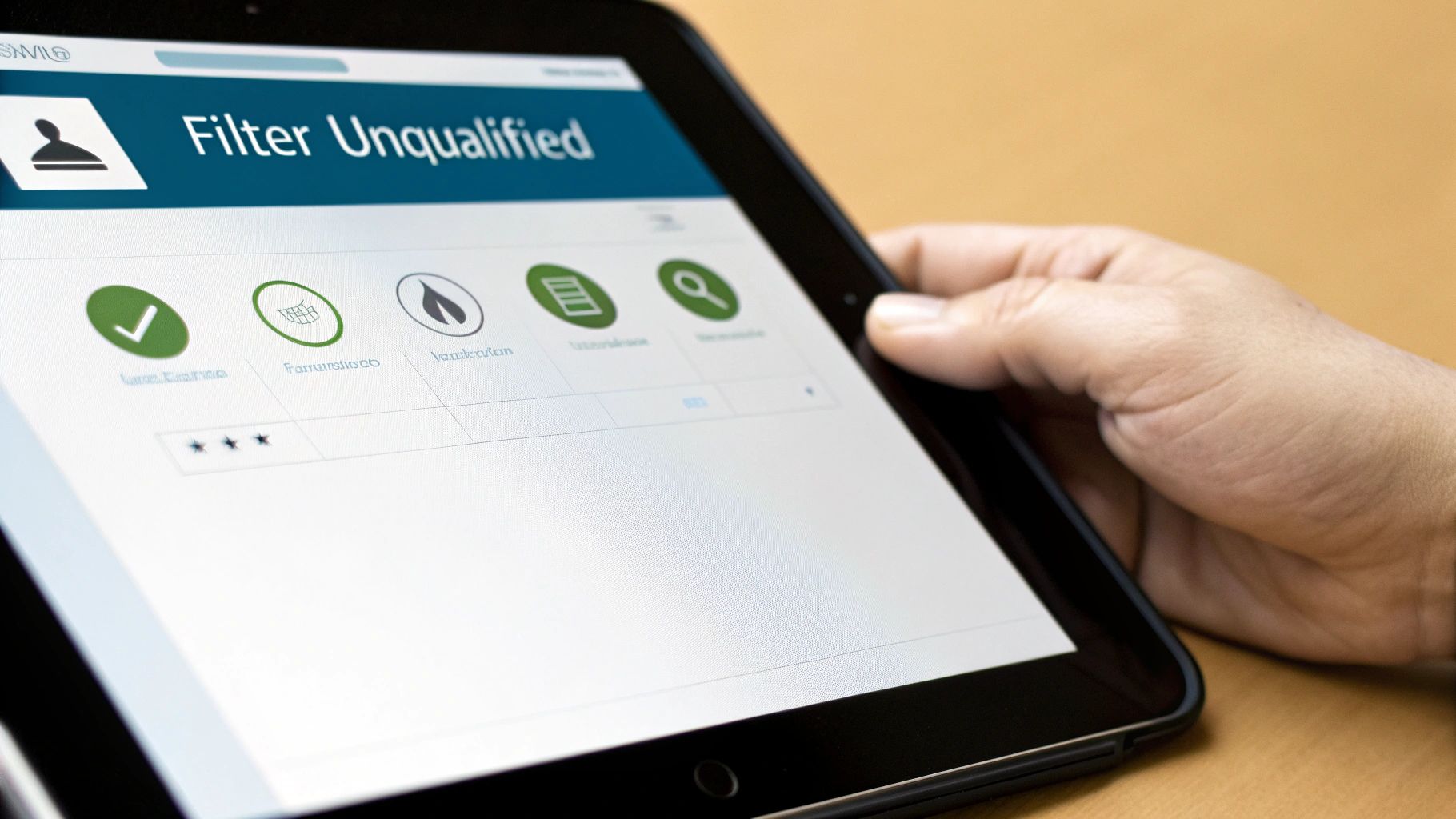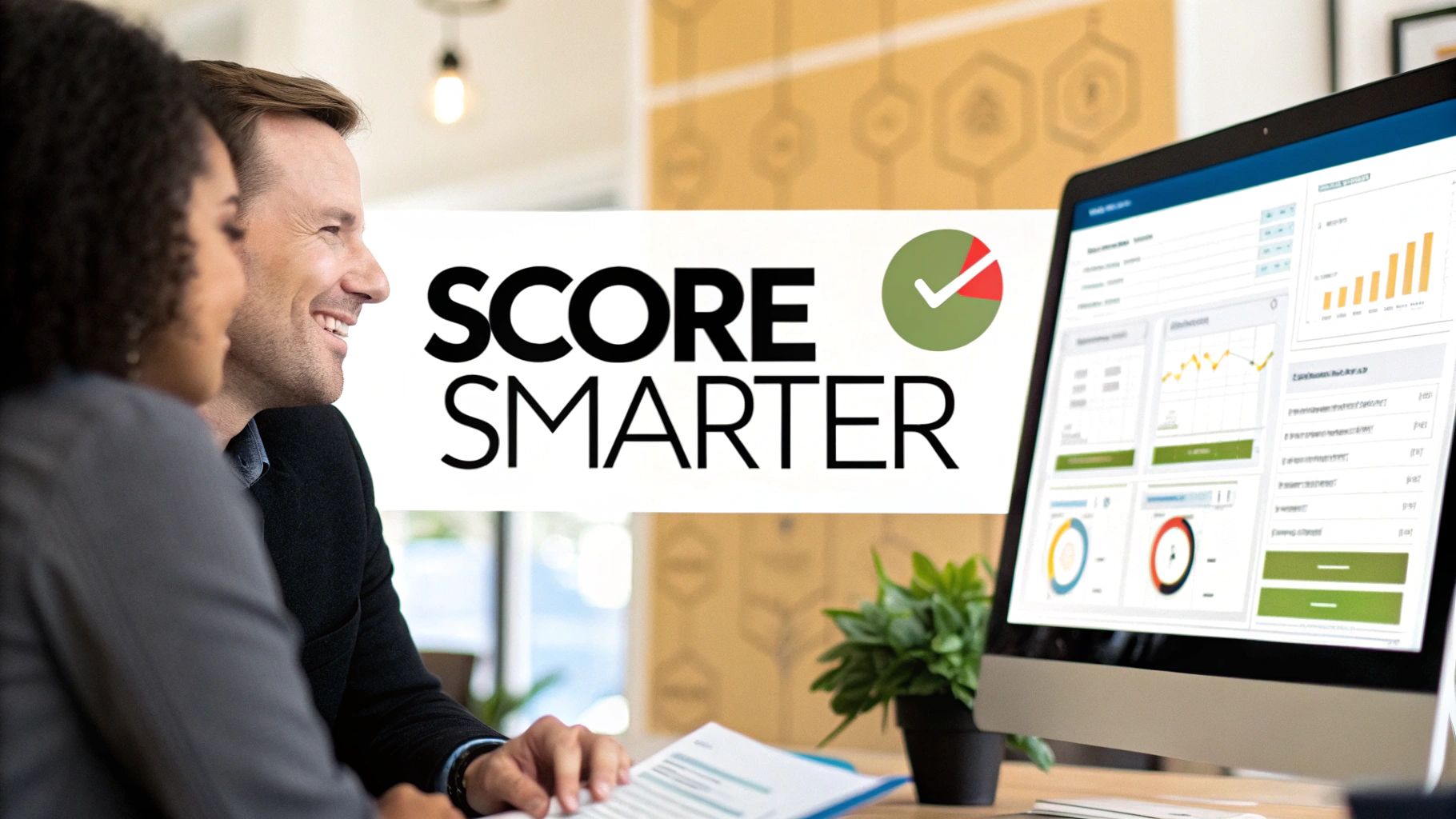Supercharge Your Sales with Smart Lead Scoring
For small and mid-sized businesses (SMBs), especially those in field sales, efficient lead management is crucial for growth. This means identifying your hottest prospects and focusing your sales team's efforts where they'll have the biggest impact. This article provides seven lead scoring best practices to help SMBs, particularly those using or considering a CRM like LeadFlow Manager, convert more leads into customers. These actionable strategies will empower your sales team to prioritize high-potential leads and close deals faster.
These lead scoring best practices are designed to be implemented within your CRM and cover a range of techniques, including:
- Defining your Ideal Customer Profile (ICP) and buyer personas
- Utilizing predictive lead scoring with machine learning
- Balancing explicit and implicit scoring criteria
- Implementing dynamic scoring with time decay
By mastering these techniques, your business can significantly improve its lead qualification process. This list skips the generic advice and dives into specific, actionable strategies. We’ll explore real-world examples and provide practical implementation details. Learn how to optimize your lead scoring system and take your sales performance to the next level.
1. Define Clear Ideal Customer Profile (ICP) and Buyer Personas
Effective lead scoring relies on a deep understanding of your ideal customers. This understanding starts with defining a clear Ideal Customer Profile (ICP) and developing detailed buyer personas. Your ICP outlines the characteristics of the ideal company you want to do business with, while buyer personas represent the individuals within those companies who make purchasing decisions. This crucial first step allows you to focus your efforts on leads most likely to convert, maximizing your sales team's efficiency and ROI. Without this foundation, your lead scoring efforts will lack direction and produce suboptimal results.

Why ICP and Buyer Personas are Essential for Lead Scoring
A clearly defined ICP and detailed buyer personas form the bedrock of your lead scoring model. They provide the criteria for identifying and prioritizing high-potential leads. This targeted approach allows you to align your sales and marketing efforts, ensuring you're focusing on the right prospects at the right time. For SMBs, especially those transitioning from spreadsheets and informal communication, this clarity is paramount for scalable growth.
Building Effective ICPs and Buyer Personas
Building effective ICPs and buyer personas requires a data-driven approach combined with qualitative insights. Analyze existing customer data within your CRM (like LeadFlow Manager) to identify trends and patterns. Look for common characteristics among your most successful customers, considering demographics, firmographics, buying behaviors, and even psychographics. Supplement this data with direct customer interviews to gain a deeper understanding of their needs, motivations, and pain points.
Examples of Successful Implementation
- HubSpot: Utilizes detailed buyer personas to score leads based on role, company size, and engagement level.
- Salesforce: Segments leads by industry and company revenue to prioritize enterprise accounts.
- Marketo: Focuses on technology adoption patterns for their marketing automation prospects. These examples demonstrate how tailoring lead scoring to specific customer profiles improves efficiency.
Actionable Tips for SMBs
- Interview existing customers: Understand common characteristics and motivations.
- Analyze customer data: Identify patterns and trends within your CRM.
- Include negative personas: Avoid wasting resources on unqualified leads.
- Regular updates: Refresh personas quarterly to reflect market changes and new data insights.
- Sales team collaboration: Validate persona accuracy and ensure alignment between sales and marketing.
By implementing these lead scoring best practices, SMBs can significantly improve lead qualification, optimize sales processes, and drive revenue growth. This structured approach provides clarity and direction, moving away from disorganized methods and towards a data-driven, customer-centric approach.
2. Implement Predictive Lead Scoring with Machine Learning
Predictive lead scoring leverages the power of machine learning algorithms and artificial intelligence to analyze historical data, identifying patterns that indicate a lead's likelihood of converting into a customer. This advanced approach goes beyond traditional, rule-based scoring by continuously learning from outcomes. It automatically adjusts scoring models to improve accuracy over time, providing a dynamic and increasingly precise lead qualification process. This is especially valuable for SMBs with limited resources who need to maximize their sales team's efficiency.

Why Predictive Lead Scoring is Essential for SMBs
Predictive lead scoring offers a significant advantage for SMBs transitioning from manual processes to data-driven sales strategies within a CRM. By automating the lead qualification process, predictive scoring frees up sales teams to focus on high-potential leads, leading to improved conversion rates and a more efficient sales pipeline. This automated approach allows smaller teams to compete effectively with larger organizations by optimizing resource allocation. For field sales teams constantly on the move, having highly qualified leads prioritized within a mobile CRM like LeadFlow Manager can significantly impact productivity.
Building Effective Predictive Scoring Models
Developing robust predictive models requires sufficient historical data. Ideally, you should have at least 1,000 closed opportunities logged within your CRM for the algorithm to train effectively. Starting with a hybrid approach, combining traditional rule-based scoring with predictive elements, can be a good starting point. This allows you to gradually transition to a fully predictive model as your data set grows. Regularly validating the model's accuracy against actual outcomes is crucial for continuous improvement.
Examples of Successful Implementation
- Salesforce Einstein Lead Scoring: Analyzes historical opportunity data within Salesforce to predict the likelihood of conversion, providing sales teams with prioritized lead lists.
- Marketo's Predictive Content: Uses AI to analyze content engagement patterns, identifying leads showing genuine interest based on their interaction with marketing materials.
- Pardot's Einstein Lead Scoring: Reportedly increased qualified leads by 30% for many users, demonstrating the potential for significant improvement in lead quality using predictive models.
Actionable Tips for SMBs
- Data Quality is Key: Ensure data within your CRM is clean and accurate to avoid skewed results. Monitor for inconsistencies and implement data cleansing processes regularly.
- Start with a Hybrid Model: Begin by combining rule-based and predictive scoring to ease the transition and allow for model refinement.
- Regular Validation: Continuously monitor and validate model accuracy against actual sales outcomes to maintain optimal performance.
- Team Training: Train your sales team on interpreting predictive scores and using them effectively within their workflow. Learn more about implementing predictive lead scoring.
- Iterative Improvement: Regularly review and adjust your scoring model based on new data and performance feedback. Predictive scoring is an ongoing process of refinement.
By adopting these best practices for predictive lead scoring, SMBs can unlock the power of machine learning to optimize their sales process, prioritize high-potential leads, and drive revenue growth. This data-driven approach provides a significant competitive advantage, allowing smaller businesses to maximize efficiency and achieve scalable, sustainable growth.
3. Balance Explicit and Implicit Lead Scoring Criteria
Effective lead scoring combines explicit data (information directly provided by prospects) with implicit data (behavioral signals and engagement patterns). This balanced approach provides a more complete picture of lead quality. It considers both what prospects tell you and what their actions reveal about their buying intent and fit. For field sales teams, understanding this balance is crucial for prioritizing leads and maximizing conversion rates.
Why Balancing Explicit and Implicit Data is Crucial
Explicit data, such as job title or company size, offers valuable insights into a prospect's profile. Implicit data, like website visits or content downloads, reveals their level of engagement and interest. Combining these two data types creates a more nuanced understanding of lead potential, allowing field sales teams to focus on the most promising prospects. This is especially beneficial for SMBs with limited resources, helping them optimize their field sales efforts and avoid wasted time on low-potential leads.
Building a Balanced Lead Scoring Model
A balanced lead scoring model considers both explicit and implicit factors, weighting them according to their relevance to your sales cycle. For instance, a high-value explicit data point, like a prospect requesting a demo, might carry more weight than visiting a blog post. Conversely, consistent engagement across multiple web pages (implicit data) can signal strong interest, even if the prospect hasn't explicitly filled out a form. The key is to assign points based on the predictive power of each action in relation to closing a deal.
Examples of Successful Implementation
- LinkedIn: Combines job title data (explicit) with content engagement (implicit) for lead scoring, allowing sales teams to prioritize engaged prospects in target roles.
- Drift: Uses chatbot responses (explicit) combined with website session data (implicit) to qualify leads. This helps identify prospects actively seeking information and solutions.
- Intercom: Scores leads based on company size (explicit) and feature usage patterns (implicit) within their platform, enabling targeted outreach to high-potential users.
Actionable Tips for SMBs
- Weight explicit and implicit factors based on your sales cycle: Consider which actions are most indicative of buying intent in your specific industry.
- Use progressive profiling to gradually collect explicit data: Avoid overwhelming prospects with lengthy forms by collecting information incrementally.
- Track key behavioral indicators like pricing page visits or demo requests: These actions often signal high buying intent.
- Set up lead decay for time-sensitive implicit signals: A prospect's engagement from six months ago may not be as relevant as recent activity.
- Test different weighting ratios to optimize performance: Continuously refine your scoring model based on conversion data to improve accuracy and effectiveness.
By implementing these lead scoring best practices, SMBs can effectively prioritize leads, improve field sales efficiency, and drive revenue growth. This balanced, data-driven approach provides a more accurate picture of lead potential, enabling field sales teams to focus on the most promising opportunities and ultimately close more deals.
4. Establish Dynamic Lead Scoring with Time Decay
Dynamic lead scoring with time decay recognizes that lead interest and engagement levels fluctuate. Unlike static scoring models, this approach automatically adjusts scores based on the recency of interactions. It gradually reduces scores for older activities while boosting scores for recent engagement. This ensures that lead scores accurately reflect current buying intent, not just historical interest, a critical factor for field sales teams prioritizing immediate opportunities.
Why Time Decay is Crucial for Lead Scoring Best Practices
Time decay prevents your sales team from chasing stale leads. In fast-paced field sales environments, prioritizing leads with active interest is paramount. This dynamic approach helps identify hot leads and ensures sales reps focus their efforts on the prospects most likely to convert now. For SMBs managing field teams, this efficiency translates directly to improved ROI.
Implementing Dynamic Scoring with Time Decay
Implementing time decay within your CRM (like LeadFlow Manager) involves defining decay rates for different activity types. For example, email opens might decay faster than content downloads, reflecting the shorter lifespan of email engagement. Align the decay timing with your typical sales cycle length to accurately reflect buying cycles within your industry. Negative scoring can also be employed to swiftly identify disengaged leads.
Examples of Successful Implementation
- HubSpot: Automatically reduces contact scores by 1 point each day without activity. This constant decay highlights active engagement.
- Pardot: Uses time-based scoring decay to identify stale leads for nurturing campaigns, re-engaging potentially lost prospects.
- Marketo: Implements different decay rates for various actions. Email opens decay quickly, while content downloads decay slower, recognizing the different levels of engagement.
Actionable Tips for SMBs
- Set different decay rates: Prioritize actions based on their significance in your sales cycle.
- Align decay timing: Reflect your typical sales cycle length. A shorter sales cycle necessitates faster decay.
- Re-engagement campaigns: Create targeted campaigns for leads whose scores decline due to inactivity.
- Monitor conversion rates: Analyze conversion rates at different score decay levels to optimize decay rates.
- Negative scoring: Deduct points for negative actions (like unsubscribes) to quickly identify disengaged leads.
By incorporating dynamic lead scoring with time decay, SMBs gain a competitive edge in field sales. This refined approach ensures sales teams are always focusing on the hottest leads, maximizing their chances of conversion and driving revenue growth. This data-driven strategy elevates lead prioritization beyond basic static models, moving towards a more dynamic and accurate reflection of buying intent.
5. Implement Negative Scoring to Filter Out Unqualified Leads
Effective lead scoring isn't just about adding points for positive actions; it's also about subtracting points for red flags. Negative scoring involves deducting points from lead scores when prospects exhibit behaviors or characteristics that indicate they are unlikely to convert or are not a good fit for your solution. This practice helps prevent unqualified leads from reaching sales teams and ensures resources are focused on the most promising opportunities. For field sales teams, this is particularly important as it minimizes wasted travel time and maximizes face-to-face selling opportunities with qualified leads.

Why Negative Scoring is Crucial for Lead Scoring
Negative scoring refines your lead qualification process, ensuring your sales team isn't chasing dead ends. It improves sales efficiency by prioritizing leads with genuine potential, especially valuable for field sales teams operating within specific territories. By filtering out unsuitable leads early, negative scoring reduces wasted time and resources, allowing SMBs to concentrate on high-value prospects.
Building an Effective Negative Scoring System
Start by identifying clear disqualifying factors. These could include competitors, individuals outside your target demographics, or companies below your minimum revenue threshold. Consider geographic restrictions if your field sales team operates within specific service areas. Within your CRM (like LeadFlow Manager), track relevant data points to automate the negative scoring process.
Examples of Successful Implementation
- SaaS companies: Deduct points for free email addresses or student domains, indicating low purchase intent.
- B2B software providers: Subtract points for competitors' email domains, as these leads are unlikely to convert.
- Enterprise vendors: Apply negative scoring for companies below minimum revenue thresholds, focusing on larger deals.
- Geographic restrictions: Filter out companies outside service areas to optimize field sales routes.
Actionable Tips for SMBs
- Start with obvious disqualifiers: Competitors or incorrect geography are good starting points.
- Use moderate negative scores initially: Adjust based on results and observed conversion rates.
- Create separate nurturing tracks: Negatively scored leads may become qualified later, so keep them engaged with targeted content.
- Regularly review and update: Negative scoring criteria should evolve alongside your business and target market.
- Balance negative scoring with positive re-engagement opportunities: Offer valuable content and incentives to re-engage leads who may have been prematurely disqualified.
By implementing these lead scoring best practices, SMBs, especially those with field sales teams, can optimize lead qualification, reduce wasted resources, and drive revenue growth. This targeted approach, when integrated with a robust CRM, ensures that sales reps spend their valuable time with the most promising prospects.
6. Create Multi-Touch Attribution Scoring Models
Effective lead scoring best practices recognize that the buyer's journey is rarely linear. Modern buyers interact with multiple touchpoints—from social media ads and website visits to email campaigns and sales calls—before making a purchase decision. Multi-touch attribution scoring acknowledges this complexity. It distributes credit across all interactions in the buyer's journey, providing a more accurate picture of what drives conversions. This nuanced approach allows for better optimization of marketing efforts and increased lead scoring accuracy. This is particularly valuable for SMBs managing multiple campaigns across various channels.
